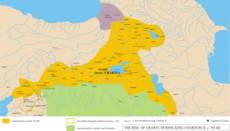

ADDRESS
Magic Carpet
Urartu Carpet
Rixos Hotel Premium
Ileribasi Mev. No:9
Belek
ANTALYA
Create your own web pages in minutes...
Create your own web pages in minutes...
Urartu
Urartu (Biainili in Urartian) was an ancient kingdom in eastern Anatolia, centered in the mountainous region around Lake Van (present-day Turkey), which existed from about 1000 BC, or earlier, until 585 BC. The name may correspond to the Biblical Ararat.
Urartu was often called the "Kingdom of Ararat" in many ancient manuscripts and holy writings of different nations. It was believed to be the site of the Tree of Life and was sought after by various kings in that era.
The reason for uncertainty in the names (i.e. Urartu and Ararat) is due to variations in sources. In fact, the written languages at that time employed only consonants and not vowels. So the word itself in various contemporary sources is "RRT", which could be either Ararat, or Urartu, or Uruarti and so on.
Urartu at its greatest extent in the time of Sarduris II, 743 BC
The Kingdom included three main tribal groups living within its territory: Nairi, Hay and Armen, all three were closely related to one another. The tribal groups living near Lake Van and, in fact, in and aroundthe capital Touchpa (Tushpa) were called "Nairi" (indicating they had fair hair and eyes). The groups to the west in central Anatolia where known as "Armens". The tribal groups to the northeast were referred to as "Hay".
The Kingdom was known as Armenia to the Greeks (and, subsequently, to the Roman Empire) living in western Anatolia, possibly due to the fact that the contacts they had with Urartu, were through the people of the tribe of Armen.In the beginning of the 6th century BC, the Urartian Kingdom fell under pressure from Assyria to the south and nomad attacks from the north and northwest. Although weakend by incursions, the southeastern parts where Hays lived remained unmolested. The Hay took over the rule of that part of Urartu's territory, remained a viable political entity and regained strength under their own name of "the land of Hays" - Hayq, Hayastan. The western territory remained under the control of the Armens, and was known as Armenia, the name by which it came to be known to the rest of the world.The aforementioned three main tribal groups had similar languages, cultures, and ethnic origins. These similarities enabled Urartian and early Armenian kings to keep their territory intact and facilitated efforts made to expand their holdings. The kingdom grew in size thereafter and eventually divided into two main parts: Greater Armenia and Lesser Armenia.
At its apogee, Urartu stretched from northern Mesopotamia through the southern Caucasus, including parts of present-day Armenia up to Lake Sevan. Archaeological sites within its boundaries include Altintepe, Toprakkale, Patnos and Cavustepe. Urartu fortresses are found in Van, Armavir, Erebuni (present day Yerevan city), Anzaf, Cavustepe and Başkale, as well as Argishtiqinili, Teishebaini (Karmir Blour) and others.
Copyright 2006 ekener.com All Rights Reserved.
